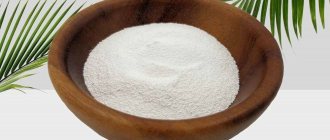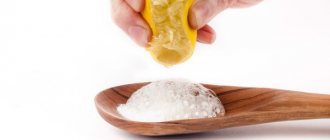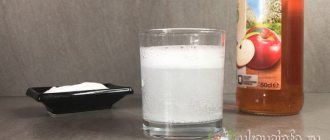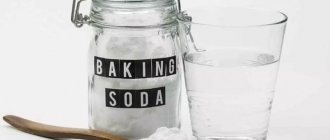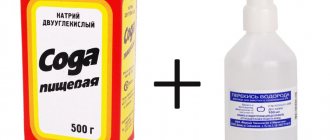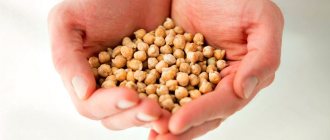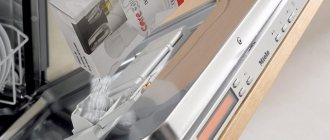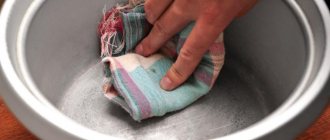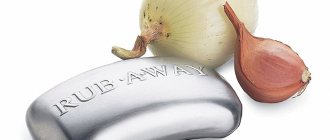Soda ash (Na2CO3) has several names: sodium carbonate, sodium carbonate, laundry soda, sodium carbonate - all these are names for the same substance. Please do not confuse it with baking soda and caustic soda; all 3 substances are alkalis, but differ in their strength and properties.
- Baking soda has an almost neutral reaction (pH-8.1) and is used for cooking and other household purposes.
- Soda ash has a more alkaline reaction (pH-11) and is not used in the food industry, only for domestic and industrial needs.
- And finally, caustic soda, also known as caustic soda, is the strongest of the 3 alkalis (pH-13), it easily dissolves fat, paper, skin, and other organic matter; if it comes into contact with the skin and mucous membranes, it causes serious chemical burns, for “domestic » purposes it is used with extreme caution.
Sodium carbonate looks like a white powder. You can purchase it in departments of household chemicals and hardware stores.
Precautionary measures
- This substance has strong dehydrating and fat-dissolving properties; in concentrated form it can cause an alkaline burn when it gets into wounds - it burns and stings. In addition, it dries the skin of your hands very much, so wear rubber gloves when working with sodium carbonate.
- Keep the pack away from food.
- Laundry soda is not used in cooking or to soften cooking water.
- In a damp room, the powder absorbs moisture and changes properties, and in the open air it cakes and clumps, so store the pack in a dry place in an airtight container.
- Make sure that the box is out of the reach of small children and pets, otherwise disaster may occur. Soda powder is quite light and scatters in different directions, getting into the eyes, nasopharynx and lungs. If suddenly this happens, you should immediately wash off the powder, if swallowed, give the victim a glass of water and immediately go to the clinic.
- The hotter the soda solution, the more active the substance, and if you calmly washed with soda in cool water, then the same concentration at a higher temperature can cause skin irritation or even a chemical burn.
- Sodium carbonate cannot cause a fire or explosion, but in terms of its effects on the body it is classified as hazard class 3.
- When combined with water, the substance becomes chemically more active, so it is not recommended to use soda ash in damp areas.
It forms flakes in cold water, so it is better to use warm water.
What is
Soda ash is used at home and on an industrial scale. The product helps fight dirt, pests, and removes greasy stains. The powder is used for disinfection and softening of hard water. Before use, it is important to find out the dosage and take precautions.
Short description
In terms of its composition, soda ash belongs to carbonic acid salts. The chemical name of the substance is sodium carbonate (Na2CO3), which is created by calcination, i.e. calcination. When interacting with water, sodium bicarbonate (baking soda) and alkali are formed, which is the active substance.
Soda ash is a crystalline powder found in nature. Soda crystals are obtained from bottom lake sediments or from algae. In industry it is obtained as a result of chemical reactions. As a food additive, soda ash is known as E500.
How is it different from food
Knowing the structure of the substance, it is not difficult to guess how soda ash differs from baking soda. Calcined is more alkaline than food grade, and due to this it is better suited for solving everyday problems. Regular baking soda can be used to clean sinks, bleach laundry, and unclog drains. However, soda ash can cope with more complex tasks. The differences between the powders are clearly presented in the table.
Table - Features of soda ash and baking soda
| Properties | Calcified | Food |
| pH level (neutral – 7) | – 11 | – 8 |
| Use in everyday life | – Destroys old limestone, greasy, rusty stains; – used for cleaning floors and plumbing equipment; – whitens clothes; – fights plant parasites; – used as fertilizer for agricultural crops | – Cleans dishes; – used as a bleach; – eliminates odors from the refrigerator; – removes scale from washing machines and dishwashers |
| Use in cooking | – Used only as a food additive E500 | – Used in baking; – neutralizes acid; – washes away dirt and chemicals from vegetables and fruits |
| Effect on skin | – Often causes irritation; – provokes allergic reactions; – dries out the skin | – Absorbs moisture and odors from the skin (can be used as a deodorant); – relieves itching from insect bites; – strengthens nails and renews the epidermis; – used as a soft peeling |
| Average price per 1 kg | – Costs 30 rubles (data as of November 2022) | – Costs 25 rubles (data as of November 2022) |
You cannot replace baking soda with soda ash. Food grade can be used as a household product for cleaning pots, baking trays, and stoves. Soda ash, which is more aggressive, can deal better with heavy stains.
Areas of use
Soda is produced on an industrial scale for various purposes. The product is used in glass melting, medicine production, and oil refining. Soda ash is also needed in the paper industry and metallurgy. The substance also plays the role of raw material for the production of caustic alkali - caustic soda.
Housewives purchase powder for cleaning various materials and surfaces:
- ceramics;
- metal;
- glass;
- enamels;
- vinyl;
- linoleum.
Soda ash softens water, preventing damage to washing machines and dishwashers. Many gardeners use a powder solution as a top dressing, an indicator of soil acidity, and an insect repellent.
Precautionary measures
Soda is a chemical compound that carries potential harm. Following four rules for storing and using the product will help protect your health.
- Store locked. Soda ash abundantly absorbs moisture from the environment, losing its qualities and caking into lumps. Therefore, it is better to keep the box with the product tightly closed.
- Distance from food products. Food powder belongs in the kitchen, and soda ash belongs in the bathroom, toilet or pantry. It is better not to pour the product into a jar without a label, otherwise the substance may be confused with baking soda or washing powder.
- Inaccessibility for children. Access to the product by children and animals must be prohibited. Unlike baking soda, soda ash can cause burns to mucous membranes and skin, as well as irritation.
- Personal protection. Before working with soda ash, it is recommended to wear gloves and, in some cases, safety glasses. It is important to ensure that the product does not come into contact with mucous membranes. If you feel a burning sensation in the eye area, you should immediately rinse your eyes with plenty of water. If irritation is severe, seek professional medical help.
Where not to use
You should protect not only yourself, but also the objects being cleaned. You cannot use soda ash to clean surfaces and materials such as:
- tree;
- aluminum;
- brick;
- varnish (parquet, furniture);
- laminate;
- dye;
- acrylic;
- PVC;
- rubber;
- fiberglass tiles.
The product is often used for washing and bleaching various fabrics. However, even in this case, there is a list of materials unsuitable for cleaning. Soda ash is dangerous for the following fabrics:
- synthetics;
- silk;
- wool;
- leatherette;
- suede leather;
- leather;
- rubberized fabrics.
Do not wash suspended ceilings, furniture upholstery, or shower cabins with a soda ash solution. If you are not confident in the strength and reliability of the material, it is better not to take risks and use a more delicate cleaning agent.
Using soda ash at home
Using sodium carbonate you can:
- Remove limescale from the kettle.
- Soak, wash, boil and bleach laundry, remove stains
- Prepare washing gel
- Clean the oven from old grease, wash the gas stove, sink, tiles
- To wash the dishes
- Use instead of CALGON
- Clear clogged pipes
- Soften water
- Wash the floor
- Get rid of mold in the washing machine
- Remove old paint
- Disinfect the room. Soda ash is widely used for disinfection in catering establishments, sanatoriums and clinics, as well as in agriculture.
- Gardeners use it to control weeds, pests and plant diseases.
Soaking laundry
Soaking and bleaching 2 in 1. Place white linen overnight in a bowl of warm water with the addition of laundry soda (3 tablespoons per bucket of water), before soaking, rub the fabric with laundry soap, Antipyatin or DURU, if there is no time , but if you have ready-made soap shavings, you can simply add them to the water. The next morning, the laundry will look the same gray as before, just wash it in the machine, choosing the appropriate program, and when the wash is finished, you will get snow-white things.
Is it possible to use soda ash for colored laundry? Yes you can, but no more than 3-5 tablespoons per 10 liters of water. The water for washing colored clothes should not be too hot, 30-40°C is just right. It is generally not recommended to boil colored laundry, especially with laundry soda.
Handwash
Sodium carbonate is an indispensable assistant when it comes to washing work clothes; it can remove stains from gasoline, fuel oil, machine oil, and paraffin. Catering workers, whose robes and aprons are daily covered with stains of custard, grease and sauces, should keep a pack of laundry soda next to the washing machine; timely use of this product will save a lot of effort and nerves, not to mention money, because soda ash is much cheaper than industrial stain removers .
Sodium carbonate is excellent for washing and bleaching fabrics made from plant materials: cotton and linen. These are the home textiles that get dirty the most: kitchen towels, cotton and linen tablecloths, bed linen. But woolen and silk items do not like an alkaline environment and this makes them hard, brittle and quickly deteriorate. As for synthetics, depending on the composition of the fabric, the effect can be unpredictable. There is no need to take risks, because synthetic items can be washed well with regular washing powder.
Attention! It is strictly forbidden to wash rubberized fabrics, leatherette, materials with different impregnations or membrane surfaces with soda ash.
Machine washable
Modern phosphate-free powders contain sodium carbonate; it does not cause allergies, is relatively safe for the environment and is completely decomposed. Knowing this, we can significantly increase the efficiency of even inexpensive washing powder. Pour the powder as usual, and add 3 tbsp to the drum. l. soda ash (if you have very hard water or things are very dirty, then the amount can be increased to 5 tablespoons). Choose a temperature range from 50 to 100°C and remember that the higher the water temperature, the more active the alkali will remove contaminants.
Boiling
Boiling is used in the most difficult cases, for whitening, removing old stains and disinfecting linen. Most often, boiling is replaced by washing in an automatic machine at high temperature, but if you don’t have a machine, you will have to use boiling water and wooden tongs the old fashioned way.
In addition to the composition, the dishes in which the laundry is boiled play an important role; a large enamel pan or galvanized steel boiler is suitable for this purpose. It is strictly forbidden to boil laundry in copper or aluminum basins or enamel containers with chips; if these rules are neglected, the laundry may become covered with ugly stains and rusty smudges. The bottom of the container is covered with unnecessary white cloth.
Digestion will be even more effective if you rub the wet laundry with laundry soap an hour before. There are several compositions for boiling, each of them effectively copes with yellowness and stains, choose based on the availability of ingredients and free time.
Composition No. 1: Place the container on the fire and add half a kilo of soda ash and 500 ml to 10 liters of water. "White" or other chlorine bleach. The laundry is boiled for an hour. This is a very effective remedy, however, it is not suitable for people prone to allergic reactions. Such digestion is not recommended to be carried out frequently, since bleach gradually destroys the fibers of the fabric and after 3-4 times holes may appear on the linen.
Do not remove hot laundry, there is a high risk of getting burned, wait until it cools down a little. Also, you don’t need to try to remove the complete evaporation; take things out with wooden tongs, put them in a bowl and take them to the bathroom to rinse. And the boiling water without laundry is not so heavy, and it will also have time to cool down while you are rinsing the laundry.
Composition No. 2: This composition is suitable for allergy sufferers; you can also boil children’s clothes in it. For 10 liters of water you need 250 grams of soap shavings and the same amount of laundry soda. We do everything in the same way as described above, but boil the laundry for about 2 hours.
Composition No. 3: The same ingredients as for the second composition, but additionally add 2 tablespoons of ammonia and hydrogen peroxide, thanks to this the boiling time is reduced to 40 minutes.
Attention! Colored linen should not be boiled - it will fade, and artificial fabrics, silk and woolen items should not be boiled.
Recipe for “Homemade” washing gel
This gel can be stored in a closed jar and used for hand and machine washing, as well as removing stains. It does not cause allergies and is suitable for children's clothes. It can be prepared with or without borax; in the first case, the product will have a pronounced antibacterial effect. For aroma, you can add a few drops of your favorite essential oil to the cooled gel.
This product is only suitable for white laundry; to get a “homemade Color Gel”, use baking soda instead of soda ash.
To prepare, we will need a saucepan that you do not use for cooking, a spoon, water, soda ash, 72% laundry soap (you can use “Children’s”, “Ushasty Nyan”, “Antipyatin”, “Tar” or “Antibacterial”) and borax .
Preparation:
- Pour half a liter of water into the pan and add 150 g. grated soap, heat, stirring continuously until the soap is completely dissolved, making sure that the mixture does not boil.
- Add 150 gr. soda ash and the same amount of powdered borax (sodium tetraborate).
- Add another 2 liters of water and heat, stirring constantly, it is important that all components dissolve completely, so the gel will not leave whitish marks on clothes.
- Pour the cooled liquid into suitable jars and place in a cool place, after a day the gel will thicken and can be used.
- Just half a glass of product is enough; it is placed directly in the drum of the washing machine or used for hand washing.
Water softening
To soften the water for washing, by the way, you can pour such water into the iron’s reservoir instead of distilled water, and then you will have to descale the iron much less often. Dissolve in 10 l. water 2-3 tbsp. soda ash and mix well, after a while a white precipitate appears at the bottom - these are “bound” calcium salts and calcium and magnesium salts. Clean water is used for domestic purposes, and the sediment is discharged into the sewer.
Attention: water softened in this way cannot be drunk or cooked with. To obtain water for bathing and drinking, soda ash is replaced with regular baking soda, the proportions are the same.
Soda Ash instead of CALGON
Is CALGON really necessary or is the danger of scale a good marketing idea? Yes and no. The fact is that hard water can really damage the machine, but this is only part of the truth.
The fact is that scale forms during washing at high temperatures, from 60°C, so if you wash at 40, then you don’t need CALGON. In addition, modern washing powders contain water softening components. After all, every manufacturer knows that powders are poorly washed in “hard” water, and competition forces them to take care of the quality of their product.
Is soft water good? Laundry is washed much better in soft water, and the consumption of detergents is reduced. The heating element of a washing machine heats up faster when there is no layer of scale on it, which saves energy. But on the other hand, too “soft” water leads to corrosion of the metal parts of the machine and gradually destroys the sewer pipes. In addition, it is very difficult to rinse clothes in soft water; too much foam is formed. Therefore, when softening water, you need to follow the exact dosage of products.
As for CALGON itself, let's take a look at the composition of the product and check, at least with the help of Wikipedia, what the ingredients are. Composition: Na2CO3 – washing soda and Na3PO4 – sodium phosphate.
Open Wikipedia and read: Na2CO3 – sodium carbonate, also known as soda ash. Na3PO4 is sodium phosphate, this substance is included in most washing powders, but in many European countries it is prohibited, as it causes increased eutrophication of water bodies. In simple terms: this process is characterized by a surge in the vital activity of algae, plankton, microorganisms (including pathogens) that release toxic substances, which kills fish and poisons animals and people. How does this affect your machine? Mold, germs and odor.
Having this information, you can decide for yourself whether you need CALGON or not, and to soften the water, just add 3-5 tablespoons of soda ash to the drum, so you can save money and not harm the environment. With the help of sodium carbonate you can get rid of mold in the washing machine; it also destroys microbes, algae, slippery deposits on the inner surface of the machine and unpleasant odors. That is why it is actively used in gardening and for disinfecting premises.
Soda ash in the kitchen
Cleaning pans from carbon deposits
We will tell you how to use soda ash to clean cutlery, enamel and ceramic dishes from burnt fat, yellowness and scale.
This method was used by our grandmothers when there was no such abundance of detergents and cleaning products in stores. Due to its fat-dissolving properties, soda ash copes with old grease no worse, and sometimes even better, than modern household chemicals.
For cleaning you will need a large metal pan, basin or boiler. We put the dishes that need to be cleaned into a container, pour in water so that our pots and pans are completely covered with water, and turn on the gas. Add a pack of soda ash and 2-3 bottles of silicate glue, a grated piece of laundry soap (optional). You can also put the dirtiest spoons, forks, ladles and other cutlery in the basin.
The time is recorded as soon as the water boils. Depending on the complexity of the contamination, boil for 20 minutes to 3 hours. The utensils are removed several at a time and washed with a regular dish sponge; even the heaviest stains are washed off without effort.
Cleaning aluminum cookware and cast iron pans
Manufacturers of soda ash do not recommend using it to clean aluminum cookware, but many housewives do this and boast about the results. We were not too lazy to find out exactly why this should not be done. It turned out that strong acids and alkalis gradually destroy aluminum, so there is no need to keep strong salt solutions, marinades, sour milk, potato and tomato dishes in such pans. How to clean them? Add regular baking soda to hot water (a weak alkali will not harm) and a little ammonia, wash the dishes with this solution, rinse with running water and wipe dry. Dark stains can be removed with a cotton swab dipped in table vinegar.
As for cast iron frying pans, everything is not so simple; they can also be boiled with soda and glue and get a sparkling surface, but along with the carbon deposits, the protective layer also comes off. And without it, frying, pancakes, cheesecakes, everything begins to stick to the pan and rust may even appear. It is difficult to restore the non-stick layer on a cast iron frying pan, but it is possible, read about it in one of our previous articles.
Washing dishes
Sodium carbonate copes with fat no worse than “Fairy”, it also easily removes carbon deposits, and whitens yellowed enamel from remaining scale. To wash dishes, use a solution (3 tbsp per liter of water), do not forget to rinse the dishes well under running water.
You can make your own powder for the washing machine; for 1 wash you need 2 teaspoons of powdered borax (borax) and the same amount of sodium carbonate.
Cleaning the oven and gas stove
We will need 3 tbsp soda ash. l, silicate glue 1 tbsp. l (sold in hardware stores as “liquid glass” or in office supplies, do not confuse it with PVA glue), half a spoon of washing powder, and a glass of water. Mix all the ingredients and lubricate the cooking surface and grates with the resulting product. After some time, the dirt will soften and you can easily wash it off with a damp sponge. In the most difficult cases, the mixture is applied a second time, slightly increasing the exposure time. The same composition can be used to clean ovens and baking trays.
This mixture can be stored in a jar for quite a long time; before use, you need to stir and, if necessary, add water. You can do it once and always have an effective and inexpensive detergent on hand.
Reviews
As the experience of many people testifies, universal soda ash has found application in the household, allowing you to clean a variety of surfaces, remove sewer blockages, and wash clothes. If necessary, it is easy to make sodium carbonate yourself from the usual drinking method by calcination.
Author ЄеИ-я asked a question in the Home Economics
Is it possible to replace baking soda ash for boiling dishes? and got the best answer
Answer from Q[guru] Soda ash Na2CO3 is more alkaline, that is, it will act more strongly on contaminants, especially fatty ones. Baking soda NaHCO3 will also give an alkaline solution, but its effect will be less aggressive. One of my friends boiled dishes with a solution of silicate glue, which also cleaned off the dirt quite well.
asked in Other How to remove blood from a white T-shirt? How to remove blood from light-colored clothes?
First of all, you need to remember that this is a protein product.
- Author: Maria Sukhorukikh
Rate this article:
- 5
- 4
- 3
- 2
- 1
(0 votes, average: 0 out of 5)
Share with your friends!
Cleaning tiles and plumbing
We can help you easily clean a bathtub, toilet or sink: soda ash, baking soda, vinegar and bleach. The whole procedure takes half an hour, the work itself takes a few minutes, the rest of the time is needed for the soda to have time to eat away the dirt. This product effectively dissolves soap deposits, sebum, limescale, urinary stone (in the toilet) and removes traces of rust around the drain and taps.
We will need:
- Soda ash and baking soda 3 tbsp. l.
- A third of a glass of liquid bleach and the same amount of table vinegar.
- Sponge and spray bottle.
Mix baking soda and soda ash, rinse the bathtub, toilet or sink with water, dip a damp sponge into the resulting powder and apply to the surface, you can rub it lightly. Leave the product to allow the baking soda to penetrate the dirt and begin to break it down.
After half an hour, apply a mixture of bleach and vinegar on top of the soda; it is convenient to use a spray bottle for this. Don't be alarmed if the product starts to hiss and foam - this is normal, as it should be. When the reaction is complete, rinse the plumbing with water from the shower head; if there are small specks of dirt left, rub them with the hard side of the dish sponge and they will be easily washed off.
To wash the tiles, use a soda solution (2-3 tablespoons per liter of water), and rinse off the remaining product with clean water.
Is your sewer pipe clogged?
Usually, pipes become clogged because hair, pieces of food and grease get into the drain, a dense plug is formed that interferes with the outflow of water, bacteria actively multiply in stagnant water and a characteristic musty smell appears. Removing a blockage is not difficult if you know how:
- You need to boil 3 liters of water and dissolve half a glass of sodium carbonate in it.
- Pour the resulting mixture down the drain (soda ash perfectly dissolves grease, soap residues and other organic substances).
- After 30-40 minutes, open the tap - running water will wash away the remaining cork and product.
Being in nature.
Back in the early 19th century, the main raw material for soda extraction was the ash of some seaweed and coastal plants. Soda ash can be found in nature in large quantities, mainly in salt formations in the form of underground ground brines, brine in salt lakes and minerals. In addition, sodium carbonate is found in the ash of a number of seaweeds, as well as in the form of such minerals:
- nahcolite NaHCO3
- throne Na2CO3•NaHCO3•2H2O
- natron (soda) Na2CO3•10H2O
- thermosodium Na2CO3•H2O.
There are over 60 such deposits on our planet. Quite significant reserves of sodium carbonate are concentrated in the USA, Canada, Kenya, Mexico, and South Africa. Soda lakes are also known in Transbaikalia and Western Siberia. The largest is Lake Natron in Tanzania, followed by Lake Searles in California. Trona, which is of great industrial importance, was discovered in 1938 as a component of the Eocene Green River Sequence (Wyoming, USA). In addition to trona, a large number of minerals were found in the mined sedimentary strata, which were previously classified as rare. For example, dawsonite [NaAICO3(OH)2], which has long been looked at as a new raw material for the production of soda and alumina. On the territory of the Russian Federation, due to the lack of large deposits, sodium carbonate is not extracted from minerals.
How to remove old paint using soda ash?
In order to clean the surface of old paint, use the following recipe:
- Dissolve a kilogram of soda in 4.5 liters. water and heat to 60 degrees (food containers cannot be used for this purpose)
- The container should be filled no more than a third, because the solution foams during heating. Add slaked lime mixed with water little by little.
- Work with the composition wearing rubber gloves, goggles and a respirator.
- Apply the “wash” to the painted surface with a brush, and when the paint begins to bubble, scrape it off with a flat spatula.
- The product will help you quickly remove old paint from any surface. After the work is completed, the residues are washed off with water or solvent.
Antiseptic properties
Soda destroys pathogens, mold, bacteria and microscopic algae; if you use it for washing in an automatic machine, then fungus will not grow in it and there will be no musty smell.
If mold appeared earlier, then you need to wash all accessible parts of the machine with washing gel based on laundry soda, the recipe for which can be read above, do not forget to bend the rubber seal on the door and wash it well under it, and also run the machine idle at maximum temperature with a glass the same gel. Borax combined with soda ash is very effective against mold. This product is also useful for removing mold from tiles.
Here you can read about how to get rid of mold on the walls without tearing off the wallpaper.
Soda ash is used for disinfection in enterprises where there is a high risk of workers becoming infected with infectious diseases, for example in hospitals, catering establishments, the leather industry, veterinary medicine and agriculture. Hot solutions of sodium carbonate are used to treat surfaces, disinfect counters, warehouses, cheese factories, and boil tools and special clothing. The hotter the water, the greater the bactericidal properties of the solution.
- An 80 degree 2-3% soda ash solution kills the foot and mouth disease virus within an hour. It deals with streptococci in 10 minutes, and with E. coli in 5 minutes.
When working with hot solutions, it is very important to follow all safety measures, wear rubber gloves and safety glasses.
What you can’t clean with soda ash
- As mentioned earlier, you cannot wash silk, wool, leather items, impregnated fabrics, membrane surfaces, leatherette and suede with laundry soda.
- There is no need to clean aluminum cookware with lye, and refrain from washing the inside of a cast iron frying pan. It is better to wash the refrigerator with a solution of vinegar or baking soda; strong alkali can damage the plastic surface and dissolve the paint.
- Alkali can ruin wooden surfaces, varnished parquet, furniture polish, and laminate.
- There is no need to wash painted surfaces with alkali; the paint may peel off after such cleaning.
- It is also not recommended to expose brickwork or fiberglass tiles to alkalis.
- In the modern world, many new materials have appeared, various types of plastics, laminated coatings, etc. Whether or not to wash them with soda ash is a controversial issue, and depends on the type of material. For example: linoleum can be washed, but laminate cannot! In our experience, vinyl wallpaper withstood the effects of concentrated alkaline paste, but no one knows what will happen to them six months after such cleaning. Therefore, you should not take risks and wash plastic and rubber products, PVC windows, acrylic bathtubs, triplex shower doors, and furniture upholstery made of leather substitutes with soda ash.
- We wrote about how to wash suspended ceilings before, but now we’ll just say that you CANNOT wash them with alkali!
Experiments
The authors of the article decided to check whether soda ash is as good as it is described. We had 4 different surfaces that we tested sodium carbonate on.
Experience No. 1 Vinyl wallpaper near an electric stove, stained with a thick layer of old grease. To combat this mess, a mixture of soda ash, Fairy dishwashing detergent and a little water was used. As for the contamination itself, having some experience, it was easy to guess that it would be very difficult to wash off this grease.
We applied the product to the stain and left it. After 15 minutes, we rubbed it with a dish sponge, and 70% of the fat was removed quite easily, the color of the wallpaper was not affected, nor was the texture, and it was decided to apply the paste again. After 15-20 min. I managed to wash away the impact a little more. The product was applied three times, and as a result, instead of a square meter of brown greasy streaks, there was a 20-centimeter area yellowed by the temperature, slightly stained with droplets of fat that were not washed off. The rest of the space was sparkling clean.
Overall, we were pleased with the result; the wallpaper was cleaned with minimal effort; I doubt that other means would have done a better job of this task.
Experiment No. 2 We washed a light-painted door with a solution of sodium carbonate and “White” with the addition of water. They applied the product, and the paint instantly turned yellow, the composition was immediately washed off, but the metamorphosis did not end there. The door, of course, became clean, but yellow, and where it was wiped with a rag, for some reason it became blue. It turned out that the door was covered with several layers of paint, presumably nitro-based, and the soda corroded the top layer of this paint, which then peeled off in small pieces for several minutes.
From this we concluded that if you need to remove nitro paint, you can use a simple mixture of sodium carbonate and bleach instead of smelly solvents.
Experiment No. 3 An electric stove covered with many years of burnt fat. This was perhaps the most difficult task. We used sodium carbonate mixed with bleach and dishwashing detergent. The process took place in several stages and took about 3 hours. The product was applied for 20-30 minutes. after which the surface was actively rubbed with the abrasive side of a dishwashing sponge and a new portion of the mixture was applied. Each time I managed to wash off a little fat.
In the end, the slab was almost washed, but as it turned out, under the layer of fat, the enamel had long been destroyed, and the fat partially performed protective functions instead. The clean but stripped slab began to look better, but in places where there was no enamel, it began to electrocute.
Experiment No. 4 A wall painted with white oil paint, near which there was a gas stove. A product based on soda and dishwashing liquid was applied 4 times with an interval of 15-20 minutes. rubbed with the back of the sponge, as a result the wall sparkled with perfect cleanliness. There was a small yellow area left, which was damaged as a result of the close proximity of the burner.
This time the soda ash worked perfectly. The paint was not corroded, only in some places the bottom layer began to show through.
We liked the product, it easily removes grease and dirt; of course, we had to work a little on the neglected surfaces on which we tested, but such contamination is quite rare. Not many modern products are able to wash off such long-term deposits the first time, and those that can most often are toxic or have a very pungent odor. The low cost of the components of our mixture is also captivating. Summarizing all the advantages, it was decided to buy soda ash for household needs.
Sodium bicarbonate is a soft alkali that well loosens the “salts” deposited inside the kettle. It is much cheaper than industrial products and does not harm health. To enhance the effect, salt, vinegar or citric acid is sometimes added to the solution. It happens that soda ash is used instead of regular soda; it copes better with plaque, but it cannot be called safe. How to descale a kettle with soda? We will tell you some effective recipes.
Mistakes when cleaning with soda and vinegar
Now let's look at this issue from the technology side. If you trust someone else’s experience and decide to implement this method of cleaning pipes, then you should not dilute the soda with water. This will greatly reduce the intensity of the already rather fleeting reaction, and in this case, you can just look at the bubbles, which are absolutely useless.
Many people advise using hot rather than cold water. Undoubtedly, temperature increases the intensity of the reaction, but since this reaction is many times faster than we are, this fraud will reduce the usefulness of this process below the baseboard, since it will happen much faster and without benefit for us.
If your sewer pipe is short and you can see its beginning and end, then I advise you to move further away. Since the intensity of this process is very high, when sealing a pipe, its force will push to the surface any plug, rag or anything else you plug the pipe with.
A mixture of water, vinegar and 70 percent sodium carbonate will erupt like a mini volcano, and can drench you, your kitchen and bathroom. Now imagine that you neglected safety precautions and this hellish solution flows off you like water. I think this is a very unpleasant outcome, and it is better to keep children and pets away from you.
In order for this method to bring even a little benefit to you and your household, it is necessary to organize the complete tightness of the sewer system. Otherwise, the gas will simply escape through the smallest holes, which you may not even notice, and you will only waste your nerves, strength, and if the outcome is unfavorable, I sincerely hope that this does not happen, also your health.
Thus, this method turned out to be 90 percent a myth. For it to work, ideal conditions are required, which an ordinary housewife clearly cannot provide. Therefore, in case of clogged sewer pipes, it is better to immediately call a plumber or use a mechanical method - a cable.
Today in stores you can find a large number of different chemicals intended for cleaning sewers. However, you can clean your pipes with baking soda and vinegar. These substances are very often used to remove small stains.
Where does scale come from?
The cause of scale is calcium and magnesium salts. When water boils, salts precipitate and form hard growths on the inner surface of dishes, boilers, and washing machines. You have probably heard that water can be “hard” and “soft”. This depends on the amount of salts dissolved in it; the more, the “harder”. When the inside of the kettle is “overgrown” with scale, the taste of the drinks noticeably deteriorates, white flakes appear in the cups, and the water has a specific smell. This suggests that it is high time for you to clean the kettle.
Causes of blockages
Blockages in sewer pipes are a fairly common occurrence. There may be several reasons for this:
- Lack of slope of the sewer circuit towards the riser or, conversely, its redundancy, excessive tortuosity.
- Accumulation of fat and dirt insoluble deposits on the inner walls of pipes. Small debris is subsequently layered on it. This leads to a gradual narrowing of the passage opening, completely blocking the sewer flow and requires careful cleaning.
- The same effect occurs due to poor water quality. The minerals included in its composition form a limescale deposit, which only thickens over time.
- Particles of earth and sand washed from shoes into the sink, or foreign objects and household waste entering sewer pipes from a toilet or bathtub, accumulate in the recesses and cling to the joint elements, preventing the free passage of drains.
- Poor condition of the pipeline. Roughness of the walls, corrosion of cast iron pipes or careless installation of joints (fracture, protrusion of O-rings, tow) leads to the formation of irregularities in the internal circuit.
What's wrong with scale?
Rust appears under the layer of limescale and gradually destroys the enamel. If you do not clean the scale for a long time, then after cleaning you will be surprised to find that there is no enamel left at all, and instead there is only crumpled, rusted metal. Now the vessel can only be thrown away or used as a container for cleaning cutlery; tea from such water will taste like rust and contain pieces of broken metal.
Scale has no better effect on an electric kettle. An ugly brown coating remains on the bottom and walls, but the biggest danger lies in the fact that salts settle on the heating element and quickly disable it; among other things, scale reduces thermal conductivity, which makes the device heat up longer and consumes an increased amount of electricity.
And most importantly: water with lime flakes cannot benefit our body and the health of our loved ones. Therefore, dear housewives, do not forget to clean the kettle from time to time.
Helpful Tips:
- Don't boil the same water twice.
- There will be less scale if you do not leave water in the kettle. For example, cooled drinking water can be immediately poured into a glass carafe.
- Clean the kettle on time, as soon as a whitish coating appears, or at least once every 1-2 weeks.
- The calcination process can also be slowed down if you use “soft” water, such as filtered or bottled.
- After each use, rinse the kettle with running water.
Preventing blockages
The best treatment is prevention. Therefore, it is better to prevent the formation of blockages in sewer pipes, and to do this, the so-called passive safety measures should be observed:
- Carefully remove food residues from dishes before washing.
- Install a protective grill on the drain hole to prevent debris and hair from entering the pipe.
- Periodically flush the system with boiling water.
- Once every 2 weeks to a month, use a light mixture of vinegar and soda to clean the drain.
How to find out the “hardness” of bottled water?
It is best to use “soft” or “moderately hard” water; by the way, this is what is needed for the tea to reveal all its unique taste and aroma. Carefully inspect the bottle, see the label. Use the table to select the appropriate water.
| The softest | up to 1.5 mEq/l |
| Soft | 1.5–3.0 mEq/L |
| Moderately hard | 3.0–6.0 mEq/L |
| Hard | 6.0–9.0 mEq/L |
| The toughest | 9.0 mEq/L and above |
Why is soda better than Antiscale?
We are talking not only about the product called “Antinakipin”, but also about all analogues of domestic and imported production. The composition usually includes fairly harmless organic acids (citric, adipic, sulfamic, etc.), but sometimes quite caustic substances, and Chinese analogues can contain anything at all.
Instructions and ingredients not written in Russian or their absence should alert you. If the composition says: “natural organic acids and auxiliary substances” - this means nothing is said! The manufacturer hides the composition of the product from you. Specific active ingredients must be indicated. It is better not to use such suspicious products, but to choose something safer for cleaning, such as soda or vinegar. After all, you drink water from the kettle yourself and feed it to your children.
After such cleaning, stainless steel cookware may suddenly become covered with black spots, which are not a pleasant task to remove. Cleaning electric kettles with Antiscale is also risky. There have been cases when Trilon, which is part of the product, corroded the nickel-plated coating of the heating disk, and the kettles had to be thrown away.
Advice: if you decide to use Anti-Scalp, carefully read the instructions and follow the dosages.
Description of the technological process
The production of soda ash using the ammonia method includes 8 main stages:
- obtaining carbonate raw materials: stripping, blasting, mining, crushing, sorting of raw materials and transportation;
- processing of carbonate raw materials: roasting, cooling and purification of carbon dioxide, slaking of lime to produce a lime suspension;
- brine purification: interaction of raw brine with reagents in reactors and brine sedimentation;
- absorption: washing gases released at other stages from ammonia in washers, two-stage saturation of a sodium chloride solution with ammonia and partially carbon dioxide coming from the distillation stage, cooling of the ammoniated brine;
- carbonization: washing of ammonia from the gas leaving the carbonization stage (accompanied by the capture of carbon dioxide), preliminary carbonization, carbonization with the release of sodium bicarbonate in precipitation columns, compression (before feeding into the carbonization columns) of carbon dioxide coming from the stages of raw material processing and calcination;
- filtration: separation of sodium bicarbonate on filters and air suction using vacuum pumps;
- calcination: dehydration and decomposition of sodium bicarbonate in soda furnaces, cooling and purification of carbon dioxide after soda furnaces;
- ammonia regeneration (distillation): preheating and dissociation of ammonium carbonates and bicarbonates contained in the filter liquid in the condenser and distillation heat exchanger, mixing and interaction of the heated liquid with a lime suspension in the mixer and distillation of ammonia in the distiller.
The entire soda process can be completely represented by the following chemical equations: NH3+H2O= NH4OH CO2+ H2O=H2CO3 H2CO3+ NH4OH= NH4HCO3+ H2O NH4HCO3+ NaCl=NaHCO3+ NH4Cl 2 NaHCO3→Na2CO3+ H2O+ CO2 CaCO3 → CaO+ CO2 CaO+ H2O= Ca(OH)2 Ca( OH)2+2 NH4Cl= NH4OH+CaCl2 NH3 H2O The mutual relationship of reactions can be represented by the following scheme: CaCO3=CaO+CO2 NaCl + NH3 + CO2 + H2O↔ NH4Cl+ NaHCO3 CaO+ H2O→ Ca(OH)2 –ΔΗ=63.8 kJ /mol Ca(OH)2 +2 NH4Cl→2 NH3 + CaCl2 + H2O+ΔΗ=27.6 NaHCO3→Na2CO3+ CO2+ H2O+ΔΗ The implementation of the chemical model involves the development of a technological regime using the physicochemical properties of an aqueous four-component system. In an aqueous solution there are 4 components NaCl - NH4HCO3 - NH4Cl - NaHCO3 (there are four independent components, because if the values of three components are known, then the content of the fourth can be calculated using the reaction equation.) The salt NH4HCO3 is formed as a result of the interaction of CO2 and NH3 in a solution: CO2 ( p) + 2NH3(p)↔NH2COONH4(p) – ΔΗ1 The resulting carbamate is hydrolyzed: NH2COONH4(p) + H2O ↔ NH4HCO3(p) + NH3(p) + ΔΗ2 — ΔΗ + ΔΗ= -63.8 kJ Temperature regime selected by the results of the reaction study, and material calculations and ratios of the reacting components were determined based on data on the four-pole system. Below are graphical methods for developing a process regime for reactions of this type. Based on the diagram (Fig. 1), it is established that sodium chloride interacts with ammonium bicarbonate, forming sodium bicarbonate and ammonium chloride, and the solubility of sodium bicarbonate in this system is low, since in an equilibrium solution 1 mole of bicarbonate dissolves in 4240 moles of water, i.e. e. practically falls into the solid phase. System Na+, NH+4║Cl-, HCO3- - H2O, T 30ºС: А-NaС1; B-NaHCO3; C-NH4HCO3; D—NH4C1; i-amount of H2O - moles of water/1 mol of Σ salts; i* - equilibrium, inp - practical R-ratio A : C entering the reaction; Р – salt composition of the solution Projection of the system Na+, NH4+║Cl-, HCO-3- H2O, Т 30ºС: А-NaС1; B-NaHCO3; C-NH4HCO3; D—NH4C1; e – salt composition of eutonic solutions of two-component systems; P – invariant points of a four-component system; R is the salt composition of the reaction mixture. The stable diagonal of the salt square, which intersects only two crystallization poles, is the diagonal of sodium bicarbonate - ammonium chloride, the ratio between the reacting components is selected graphically according to the projection of the diagram, taking into account the need to obtain sodium bicarbonate that does not contain ammonium salts in the solid phase. This technique is illustrated in Fig. 3. It consists in creating a slightly increased water content in the solution compared to the invariant figurative point P1, to which the crystallization beam is directed. Cross-section of the diagram according to ARP1: i*LBN – amount of water in the equilibrium solution; iR.pr – amount of water in the process solution; ip1 is the amount of water in solution P1; R – figurative point of the reaction mixture. The essence of the process can be expressed in such a way that when treating a brine saturated with ammonia with carbon dioxide, first there is a sort of neutralization of this solution with carbon dioxide, accompanied by a significant release of heat, and then, as the concentration of the average ammonium carbonate salt in the solution increases, its exchange decomposition with table salt to form soda, which, upon further action on the carbon dioxide solution, forms the least soluble compound - bicarbonate. From a practical point of view, it is interesting not only the course of the reaction and the achievement of the best yield of bicarbonate, but also the quality (physical properties, structure) of the resulting bicarbonate precipitate. Under factory conditions, when the precipitation of bicarbonate begins at a slightly elevated temperature, and the growth of crystals occurs upon cooling, the result is a coarse, crystalline, well-settled, well-filtered and well-washed precipitate. The cooling limit in factories is most often a temperature of 28 – 30ºС, but sometimes lower – up to 25ºС. The structure of the sediment is of great importance, since the ease and speed of filtration and washing reduces the consumption of steam for the distillation of mother liquors, and, in addition, reduces the moisture remaining in the bicarbonate after filtration, which in turn facilitates the calcination of the sediment and reduces fuel consumption for this process. Too much cooling causes the formation of very fine, silt-like sediment, which is difficult to filter and disrupts and increases the cost of normal production. Purification of table salt brine At soda factories, raw brine is purified from impurities using the lime-soda method. In this case, soda is used to precipitate calcium salts, and a lime suspension is used to precipitate magnesium salts. The lime-soda method is based on ion exchange reactions leading to the formation of sparingly soluble calcium carbonate and magnesium hydroxide: Ca2++CO32-↔CaCO3; Mg2++2OH-↔Mg(OH)2 The completeness of the release of magnesium and calcium ions into the sediment, and therefore the degree of purification, is determined by the solubility of CaCO3 and Mg(OH)2 in a sodium chloride solution. An indirect parameter characterizing the completeness of the release of Ca2+ and Mg2+ into the sediment can be the pH value, which is important when creating an automatic control system for the purification process. The main difficulties of the first stage of brine purification are the low rate of thickening of the magnesium hydroxide suspension and the unsatisfactory rate of filtration of the thickened suspension. It has been established that during the precipitation process, the formation of an amorphous (or close to amorphous) product with a fairly high solubility occurs. The duration of its existence depends on the composition of the mother liquor, temperature and properties of the alkali used. This product is hydrated magnesium hydroxide: Mg(OH)2·(H2O)m. The distance between the cleavage planes of such a hydroxide is greater than the length of the water molecules. The process of sediment ripening, which can last several days, can be described by the equation Mg(OH)2·(H2O)m→ Mg(OH)2+mH2O; 1
What's good about soda?
Sodium bicarbonate (baking soda) is a white crystalline powder, a weak alkali, used in cooking and baking. As a universal product, it is widely used in everyday life; it can easily clean the oven from grease, bleach laundry, and clean the bathtub. The main advantage of the product is its safety. It’s not scary if a box of baking soda falls into the hands of a small child. During boiling, it does not emit caustic fumes and completely decomposes at a temperature of 60 degrees.
Sodium bicarbonate loosens limescale, disinfects surfaces and removes odors; using a saucer of soda can get rid of the unpleasant smell in the refrigerator, don’t you believe it? But in vain.
It is used to clean enamel, steel, glass, ceramic and electric kettles. It is impossible to ruin dishes with soda. The good news is that after cleaning, no substances harmful to human health remain on the walls of the dishes.
Cleaning with soda, “grandmother’s” recipes
Soda
This method is suitable for electric and regular steel, enamel and teapots. Fill the container 2/3 full with water and add 3 tablespoons of baking soda. Boil for 20 minutes. and leave for an hour. If the layer of scale is small, then this procedure is enough to make the kettle sparkle like new.
However, this method is not suitable for a thick layer of scale. Soda, of course, is a good leavening agent, not without reason, bakers use it, but it cannot completely remove limescale, although it makes it more porous and loose. The softened plaque can be scraped off with a metal mesh. Soda is often mixed with other ingredients: salt or acids (lemon, vinegar, citric acid), they enhance its effect.
Soda with salt
How to descale a kettle using baking soda and table salt? Pour a full kettle of water and add 2 tablespoons of soda and a spoon of salt, stir well and put on fire. There is no need to drain the boiled water; let it stand for 10-15 minutes so that the composition has time to dissolve the hard crust of scale.
Wash the inside of the kettle under the tap and remove any remaining deposits with a dish sponge. Rinse well and add fresh water, boil for a few minutes and pour out, repeat again to be sure to wash off any remaining scale.
This “home” method is quite effective; it was possible to wash off very thick layers of scale with its help; if the case is too advanced, then the process is repeated again or triple cleaning is used, which will be discussed below.
Soda and citric acid
This simple method is suitable for regular and electric kettles. Pour water and turn on the kettle, after adding 2 teaspoons of soda and citric acid for each liter. Let the water boil for 15 minutes and turn it off. While the water cools, citric acid and soda will destroy the layer of limescale.
After about an hour, drain the water and repeat the whole process again. This method gives good results even when other means are powerless. Rinse the inside of the kettle with water; if small islands of scale remain, rub them with a sponge. Boil clean water and drain to remove any remaining acid and alkali. If you have an electric kettle, inspect it carefully to see if all the scale has been removed from the heating element? Remove and rinse the mesh, put it back and you can use the device as usual.
Triple cleaning
To work, we need citric acid, soda and vinegar. The essence of the method is that the scale layer is alternately exposed to three different solutions, which makes this cleaning as effective as possible even in the most severe cases. So, let's begin:
- Fill the kettle with water and add soda to it at the rate of 1 tbsp. l. per liter The solution is boiled for one hour and poured out.
- Prepare a solution of citric acid, the proportions and exposure time are the same as for soda.
- For the third boiling, use table vinegar (100 g per liter of water), when the solution has boiled for an hour, e
Second option
Unlike the first method, when dry soda is poured, it is necessary to prepare a solution in advance that will be poured into the pipe. This technology is used to clear pipes from blockages into which it is difficult to pour dry powder.
- Pre-treat the pipe by pouring about two liters of boiling water into it;
- Leave the pipe alone for 20 -30 minutes;
Then a solution is prepared. For one part baking soda you need to take three parts boiling water. The solution must be thoroughly mixed, heated and poured into the pipe.
- Wait about 5 - 10 minutes, then add vinegar. The amount of vinegar should be approximately equal to the volume of soda.
Then the operation is performed similarly to the first method. The drain must be closed and wait one hour. The effectiveness of this method is not very high. If a severe blockage has formed in the pipe, this treatment will have to be repeated several times, or use a special cable.
